The Retail Radeon HD 7870 Review: HIS 7870 IceQ Turbo & PowerColor PCS+ HD7870
by Ryan Smith on March 19, 2012 9:00 AM EST- Posted in
- GPUs
- AMD
- PowerColor
- Radeon HD 7000
- HIS
Overclocking: Power, Temp, & Noise
Of course no review of the Radeon HD 7000 series would be complete without a look at overclocking. In all of our testing AMD’s Southern Islands GPUs have proven to be impressive overclockers, including the reference 7870. In our 7870 review we hit 1150MHz on the core and 5.4GHz for the RAM, which made for a rather hefty overclock.
Our retail cards in turn one up the reference 7870. For core overclocking we hit 1200MHz on both cards, which is a 100MHz (9%) overclock over their factory overclocks, for a total of a rather incredible 200MHz (20%) overclock compared to a 7870’s stock clock. Given the overclockability we’ve seen for the Pitcairn GPU it’s unlikely that HIS, PowerColor, and other partners are having to do too much work for their factory overclocked cards, but we believe there’s at least some simple binning going on here, which would explain the better overclocks we’re seeing on these retail cards.
Interestingly this is all without overvolting of any kind. There still aren’t any tools capable of voltage control on the AMD reference PCB, so the limit is what you can get at reference voltages. If Pitcairn responds well to overvolting though, things could get very interesting in the future.
Memory overclocking wasn’t quite as eventful however, largely due to the fact that all of our 7870s use the same PCB and the same memory chips. Beyond 5.4GHz performance starts to plateau due to error correction. This is still a 500MHz (10%) memory overclock for the PCS+ HD7870 and a 600MHz (12%) memory overclock over the IceQ Turbo 7870 and stock 7870, but at this point GPU overclocking is eclipsing memory overclocking.
So what does a core clock of 1200MHz and a memory clock of 5.4GHz get you? In short, a lot of performance. But first, a look at power, temp, and noise.

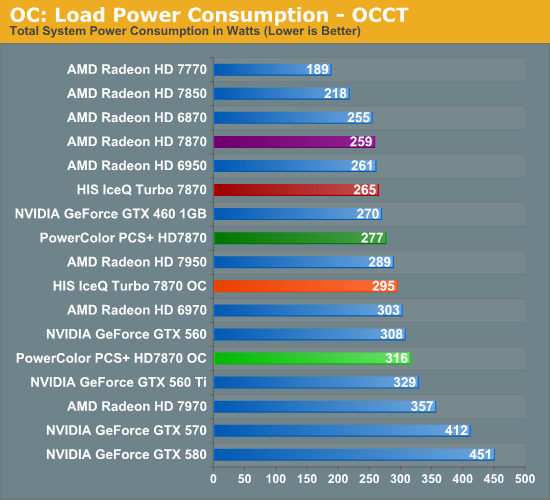
The power costs of this overclock are rather consistent for both cards. Under Metro these overclocks drive up power consumption by about 20W at the wall. Meanwhile under OCCT with PowerTune set at +20% (228W), power consumption jumps up by roughly 30W, which is more in line with the shift in PowerTune limits to prevent throttling than it is from the overclock itself. All things considered these aren’t massive increases in power consumption, but on top of the factory overclock it adds up. The PCS+ HD7870 in particular is 42W over the reference 7870 in Metro, which goes to show that while overclocking without a voltage increase doesn’t drive up power consumption as quickly, it can certainly have an impact.
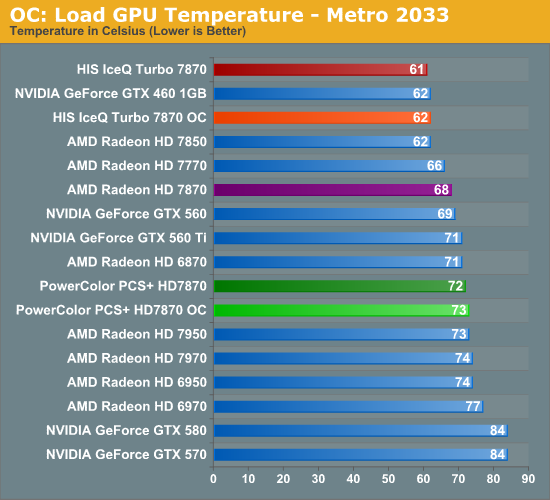
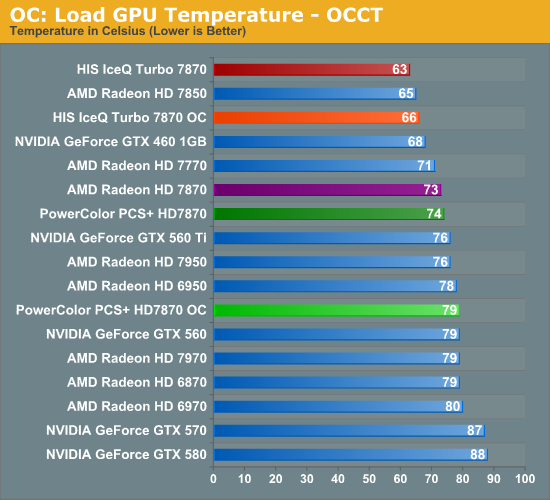
With the increase in power consumption comes the requisite increase in temperatures. At 79C under OCCT the PCS+ HD7870 is still well within our comfort zone, and this is the pathological case. Under Metro the increase is but a fraction, with temperatures going up by only a single degree.
Meanwhile the IceQ Turbo 7870 continues to flaunt its unusual cooler here. Under Metro it reaches a still relatively chilly 62C, and even OCCT can only get the card up to 66C, which is practically unheard of for a 190W card. Once HIS gets voltage controls working, voltage tweakers may very well end up having a field day here as there’s a good 15C+ of thermal headroom to play with on the GPU. Assuming of course that the VRM circuitry on the AMD reference PCB can hold up to further abuse.
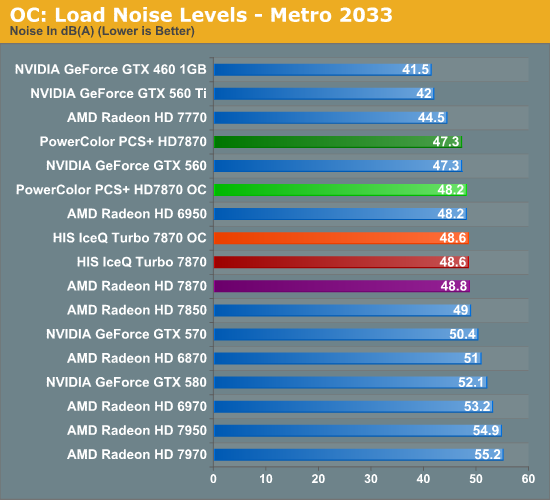
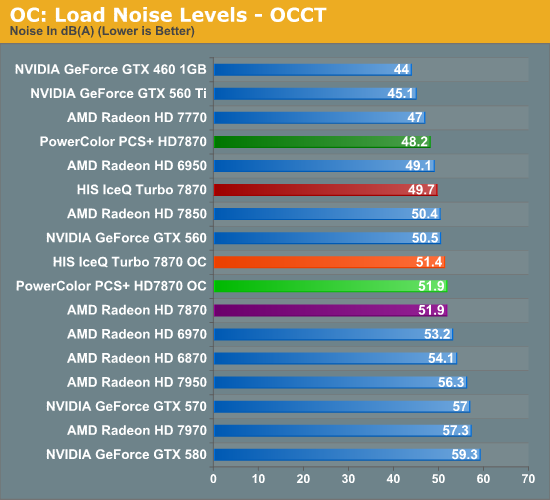
Finally, when it comes to noise the fact that temperatures don’t significantly rise under Metro means that there’s a minimal shift in load noise here. Our double overclocked cards are still quieter than the reference 7870, which in the case of the IceQ Turbo is thanks in large part to its low temperatures requiring no further work from the fan. Meanwhile the PCS+ gives up most of its noise advantage here. OCCT on the other hand finally sees every card jump up above 50dB, with both cards tying or beating the reference 7870 by a fraction of a decibel.
Ultimately the second overclock does have an impact on power consumption, but particularly when paying attention to gameplay as opposed to the pathological OCCT, the cost is very cheap. Unless you’re on a specific power budget or need to stay below the equivalent of 50dB on our charts, there’s still a fair bit of headroom to play with on these retail 7870s.










53 Comments
View All Comments
Tator Tot - Monday, March 19, 2012 - link
On the first page, you make an error in the table saying the PCS+ is Triple Slot while the IceQ Turbo is Dual Slot; obviously this is backwards based on the photos.CeriseCogburn - Tuesday, March 20, 2012 - link
How about the biggest error of all... no mention of the near paper launch - we get a pretend scenario that the 7870 and 7850 are somehow populating retail channels... no mention in the entire article of the terrible near non supply.Instead we get the reviewers wined and dined at Cebit and or GDC, where they are treated to the "unveiling", then handed special overclocked models, then we all get to pretend you could buy it up as of yesterday...
Nope, egg had 2, one sold and the buyer commented that made 1 available (7870). Same thing earlier. 7850 wasn't any better.
So AMD gets a giant pass on their near pure paper launch.
Is that free weeks long yearly for 500 'reviewers/reporters' AMD posh Island Vacation bribe coming up soon or what - did they just get back from it ?
blanarahul - Tuesday, March 27, 2012 - link
What is the use of scheduling? Is it only useful for compute or does it have usefulness in graphics also?warmbit - Tuesday, April 10, 2012 - link
Here is the link to an interesting overview performance 7870 and 7850 of 5 Web sites competing Nvidia cards - GTX580 and GTX570 and penalties of the previous generation AMD - 6970 and 6950.Analysis of the results of the Radeon 7870 and 7850 in 12 games and 5 resolutions:
http://translate.google.pl/translate?hl=pl&sl=...
You will know the relationship between average interest rates these cards and you will find out in which graphics card is better in the game and resolution.
LuxZg - Monday, March 19, 2012 - link
You've put tripple width and 390$ for PCS, while you say otherwise in article. Tripple width and 390$ is mentioned in part about HIS card, so I believe you've mixed up the columns.. or at least part of data, as memory OC seems to be correct for both cards in table. Please review and correct as not to confuse readers..CeriseCogburn - Wednesday, March 21, 2012 - link
I see this 7870 is virtually the same as the GTX 570, and when I check the prices a GTX570 is $260-$289 and the 7870 is $369 minimum.This card at it's current price is no value at all.
Zebo - Monday, March 19, 2012 - link
For comparison sake you should throw a $309 GTX 570 Classified in there. (which will beat it) But OC to OC is only fair.medi01 - Tuesday, March 20, 2012 - link
If 7870 is overpriced, then what is GTX 580?Zebo - Tuesday, March 20, 2012 - link
Cheaper than these cards and faster!http://www.newegg.com/Product/Product.aspx?Item=N8...
nevertell - Monday, March 19, 2012 - link
On the 4th page:Numerous times before we’ve seen loud & cool cards, but it’s rare to come across a loud and quiet card.
You should give the article to other editors before you publish it. Happens to myself all the time.